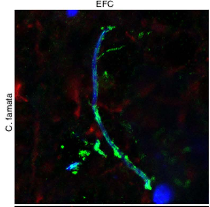Submitted by GAtherton on 20 October 2015
 A research paper that may change how we look at treating Alzheimers Disease has been published in Nature Scientific Reports that demonstrates fungal material (NB not Aspergillus species as yet) is present in brain tissue from Alzheimers patients, but not in the brains of healthy people. This is not the first time this has been suggested but now the evidence looks much more convincing.
A research paper that may change how we look at treating Alzheimers Disease has been published in Nature Scientific Reports that demonstrates fungal material (NB not Aspergillus species as yet) is present in brain tissue from Alzheimers patients, but not in the brains of healthy people. This is not the first time this has been suggested but now the evidence looks much more convincing.
Pisa et. al. (Madrid, Spain) looked at brain tissue from 10 patients and found extensive evidence for the presence of fungal material. Previously it had been suggested that this was caused by the presence of a ‘fungus’like’ protein in these diseased brains rather than the presence of real fungi growth but this team have published images of what they have found that look compellingly like fungal structures – see green/blue structures in the attached image.
The paper mentions two earlier isolated cases from different studies where antifungal medication was given to what appeared to be Alzheimers patients and complete recovery resulted – something that would be very encouraging if confirmed in a far larger number of patients.
It must be firstly stated that even if these fungal infections are shown to be present it might be the result of Alzheimers impact on the brains of its victims rather than the cause – note that the Pisa et.al. are careful to not claim that the fungal infection has caused Alzheimers disease in these patients. Nonetheless it would be difficult to think that such an infection would not be contributing to the illness, particularly in its later stages.
This is a fairly short report and is hugely encouraging, but far more details of exactly what has been done is needed for a full critique to take place.
News archives
-
Title
Date
